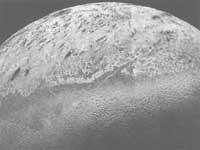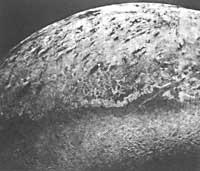Triton Hidden Protection
1993/01/01 Elhuyar Zientzia Iturria: Elhuyar aldizkaria
Triton, the largest satellite on the planet Neptune, has a mystery to astronomers. It hardly has an atmosphere (the density is 65,000 times lighter than the terrestrial one), but in spite of this, on the surface there are hardly any traces of meteorological impact, much less than on similar planets and satellites.

However, American astronomers Michael Nolan and Jonathan Lunine have recently published a theory based on Triton's history. Apparently, Triton, when Neptune appropriated him during the formation of the Solar System, suffered internal friction to obtain an orbit in the form of circumference. Therefore, heat and volcanoes were formed, and consequently atmosphere. It had between 30 and 50 times more pressure than the terrestrial one and was formed by nitrogen, methane, carbon dioxide and hydrogen.
As a consequence of the greenhouse effect of hydrogen, the surface temperature of Triton increased between -130 and -90° C (nowadays it has a temperature of -236°), giving rise to the ammonia oceans.
This situation lasted 100 million years and during that time (atmosphere, sea, volcanoes, etc. ). All the leaped meteorites would have been removed in the air before they hit the ground.

Gai honi buruzko eduki gehiago
Elhuyarrek garatutako teknologia





